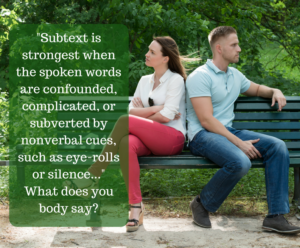What Are You Trying To Say? The Art of Subtext by @CarolAnneMalone
 From the archives, I’m bringing back this post on subtext.
From the archives, I’m bringing back this post on subtext.
***
Please welcome author and book coach in-training Carol Malone. Today she’s sharing her article about why we should write subtext into our stories and how. “What Are You Trying To Say?” Enjoy!
***
During a romance novel critiquing session, one of my co-author’s comment to me was, “You need more subtext in your dialogue.”
Now I had heard the word “subtext,” but I’d never consciously worked “subtext” into my writing. Or so I thought.
So, I asked:
“What is subtext?”
I Googled “subtext, and was amazed.
Sue Weems on The Write Practice.com said:
“Subtext is the message sent beneath the words we say. It can be carried by nonverbal cues, such as eye-rolls or silence, but it’s strongest when the spoken words are confounded, complicated, or subverted by the message implied. We sometimes call this ‘reading between the lines…’ “
At www.writingclasses.com an article titled “In Dialogue, what is subtext?” the author states,
“Subtext is the meaning beneath the dialogue; what the speaker really means, even though he’s not saying it directly.”
Cris Freese explained subtext in her article “Creating Setting and Subtext in Your Fiction”:
“Subtext is not what we say in our story but how we say it. It’s the secondary message we give our readers. The ones we want them to understand without telling them directly. Subtext adds depth and complexity. It builds an experience that remains in the readers’ awareness.”
A message sent between two people, or maybe more, the hidden message beneath the words our characters say.
I get the meaning of the hidden or mixed messages.
It’s like in the Godfather, when Don Corleone tells his cry-baby, no-account actor godson, Johnny Fontane, “I’ll make him an offer he can’t refuse,” so he can get a movie part. We know right away the poor old producer is in for a nasty treat.
Voilà ! Subtext.
“I’ll make him an offer he can’t refuse.”
I know many of us have used that phrase with our children or others we wanted to highly motivate. Only we meant we’d restrict TV viewing or the use of the car, not murdering someone’s prized race horse.
Subtext. The meaning beneath the words.
Okay, if this subtext is reading between the lines for the reader, how does the writer write between the lines dialogue?
When I started to think about the use of subtext, I didn’t have to go much further than my own relationship with my husband.
My husband wanted something. He said to me:
“Is your Amazon prime account still good?” he asked staring at his computer.
“Yes. I just signed up for movie prime,” I said and continued typing on my computer.
“Movies, great. Is my account still active?” he asked.
“How should I know?” I said. “Just check under ‘My Account’ on your homepage.”
“It still pays for free shipping?” Folded his arms, his tone annoyed.
I shook my head, annoyance swelling. “Of course. Why wouldn’t it?”
“I was just asking.”
“What are you asking?”
“Oh, nothing.”
After a bit more back and forth, I finally drug out of him the fact that he wanted to buy a book and he’d canceled his Amazon prime account. Sometimes we waste a lot of time with subtext, but it does make for lively conversations.
How can we write subtext into our novels?
In her article “5 Techniques for Adding Subtext to your Story,” Becca Puglisi of Thesaurus fame offered five techniques to aid us in incorporating subtext into our stories.
Becca’s techniques:
- Give you character an objective:
We all have an objective, whether we realize it or not –- “big picture” objectives (buying a house) and “small picture” objectives (going to the bathroom). Your character should have something that drives them. The only thing that will drive them is an objective -– a goal. Furthermore, having a goal will automatically add subtext to everything they say.
- Give your character an action:
Now that the character has a goal, you have to give them the means by which they can achieve that goal. Try not having your character attempt to achieve his/her goal by deliberately asking for it. Instead, let them use their body language, or their tone of voice, to show what they want.
- Make your characters talk in gibberish:
It might sound strange, but when you replace all your character’s dialogue with gibberish, the subtext is revealed, or at least hinted at. On the other hand, if you did a great job of developing the subtext of the story, then your reader should have a general idea of what’s going on in the scene — even when the characters are talking nonsense.
- Give your character a secret:
When you give a character a secret, it instantly makes them more interesting.
- Give a character a secret about another character:
What is more tantalizing than a character with a secret? A character who knows another character’s secret. When you put those two characters together in a room it makes for a very fascinating scene — chock full of delicious, delicious subtext. Yum!
Nine steps to writing good dialogue with subtext:
I found another great list of subtext writing steps from Charles Harris’ article “9 steps to writing dialogue with rich subtext.” See if these steps give you more insight in subtext.
- Subtext is a muscle, like any other writing skill. You develop it by working it. At first it may seem hard but after putting in the hours you’ll find you start to develop an instinct. You’ll know when a line is “on the nose” and needs to be made more subtle and oblique. Be patient, work hard and the muscle will grow stronger.
- First write the “text.” Talking to other writers, I found we all did the same. Our first drafts are full of dialogue that is unsubtle and too direct.
She starts to walk away.
MIKE
I don’t want you to go just yet.
CLAIRE
I can stay a little longer.
MIKE
Let’s talk.
Then when we redraft we take all those lines and find ways of hiding those thoughts by having our characters talk (overtly) of other things.
She starts to walk away.
MIKE
Claire?
CLAIRE
Hmm…
MIKE
(holds up crossword)
You wouldn’t happen to know what language they speak in India, do you?
(From Someone to Watch Over Me)
- Listen to how real people talk. There’s nothing like a good dose of reality. Listen to the dialogue that people create naturally and ask yourself what they are really thinking. Then ask yourself how you know.
- Read, read, read. Do some detective work. Spy on how the great novelists, short story writers, screenwriters and playwrights do it. Then steal as much as you can get away with.
- Try this exercise. Create two random characters and give them something they mustn’t mention. Say, two prisoners are waiting to be hanged. They talk of anything but that — the weather, their last meal, a mouse in the cell. See how every word, every pause, can be filled with unspoken meaning.
- Know your characters inside-out. One reason that it’s difficult to write subtext on the first draft is that you don’t yet know the characters well enough. Ibsen used to say, about writing plays, that in the first draft your characters are strangers. In the second draft they are friends, and by the third they are close family.
- Practise, practise, practise. Keep a notebook with you always and jot down ideas for lines that come to you, lines that reveal without saying. When you’re waiting for a train or walking along the street, play with dialogue in your head. Keep exercising that muscle.
- Cut, cut, cut.
Mary toys with her food. She looks up at Frank.
MARY
Do you love me?
FRANK
I have to admit that I don’t really love you very much.
MARY
That makes me feel very unhappy, but I’ll just have to get on with it, even though my heart is breaking.
It’s fascinating how much can be revealed by a question that is left hanging after you’ve cut the answer. Or an answer given to a question that’s not been asked. Find creative ways for your characters to change the subject, or the reverse: return to an old subject.
Mary toys with her food. She looks up at Frank.
MARY
Do you love me?
Frank says nothing but stares at his plate.
MARY
I’ll get the dessert, then. It’s trifle. Your favourite.
- And finally, in writing as in real life, sometimes emotions are running so high that people do actually say what they are really thinking. They blurt out their love, their fear, their hope. But even then, there is almost always a subtext beneath their directness. Even as your character says, “I love you” there’s still something that’s not being said.
Many more writing gurus have spoken to this topic of how to write brilliant subtext and show impactful subtext through body language. I don’t pretend to understand it complete at this point.
Like one guru suggested, practice, practice, practice, and then listen to people talk, to their conversations and listen and watch for the subtle cues that the person is not saying what they mean. Examine your own conversations. What do you have to hide or what are you trying NOT to say?
I’m going to end my discussion about subtext with my favorite movie, and really fascinating example of movie subtext. I’d be interested to know what you think about this discussion. Please leave me a comment with your thoughts.
Script from the movie, Social Media by Aaron Sorkin. (He must have been on mushrooms.)
MARK ZUCKERBERG: Did you know there are more people with genius IQ’s living in China than there are people of any kind living in the United States?
ERICA (Mark’s date): That can’t be true.
MARK: It is true.
ERICA: What would account for that?
MARK: Well first of all, a lot of people live in China. But here’s my question: How do you distinguish yourself in a population of people who all got 1,600 on their SAT’s?
ERICA: I didn’t know they take SAT’s in China.
MARK: I wasn’t talking about China anymore, I was talking about here.
ERICA: You got 1600?
MARK: You can sing in an A Capella group.
ERICA: Does that mean that you actually got nothing wrong?
MARK: Or you row crew or you invent a $25 PC.
ERICA: Or you get into a final club…
MARK: Or you get into a final club, exactly.
ERICA: I like guys who row crew.
MARK: (beat) Well, I can’t do that. And yes, it means I got nothing wrong on that test.
ERICA: Have you ever tried?
MARK: I’m trying now.
ERICA: To row crew?
MARK: To get into a final club. To row crew? No. Are you, like—whatever—crazy?
ERICA: Sometimes, Mark—seriously—you say two things at once and I’m not sure which on we’re talking about.
MARK: But you’ve seen guys who row crew, right?
ERICA: No.
MARK: Okay, well they’re bigger than me. They’re world class athletes. And a second ago you said you like guys who row crew so I assumed you’d met one.
ERICA: I guess I meant I like the idea of it. The way a girl likes cowboys.
MARK: The Phoenix is good.
ERICA: This is a new topic.
MARK: It’s the same topic.
ERICA: We’re still talking about the final clubs?
MARK: Would you rather talk about something else?
ERICA: No, it’s just that since the beginning of the conversation about finals clubs, I think I may have had a birthday.
***
ABOUT THE AUTHOR
 Award-winning author, Carol Malone writes new pulp-fiction suspense kissed with romance to rocket readers into the past. When not hammering out new tales, Carol is reading, or watching the Dodgers, HGTV, and the Food Network with her writer husband on the coast of California. She loves to connect with you and invites you to chat about romance and sports on her website, Facebook, or Twitter.
Award-winning author, Carol Malone writes new pulp-fiction suspense kissed with romance to rocket readers into the past. When not hammering out new tales, Carol is reading, or watching the Dodgers, HGTV, and the Food Network with her writer husband on the coast of California. She loves to connect with you and invites you to chat about romance and sports on her website, Facebook, or Twitter.
Check out Carol’s Books: new pulp-fiction suspense kissed with romance to rocket readers into the past
Fight Card Romance: Ladies Night ; Fight Card Romance: Ladies Night Christmas ; Summer Holiday







Carol, yet another brilliant article. Subtext is hard. There have been times I found it in my own writing and never knew how it got there, nor how to reproduce it elsewhere. The way you laid it out made it so much clearer, especially with the nine steps. and Steps 1, 3 and 8 resonate with me. I need to practice, listen more to real people and keep it simple. Thank you!
Thank you for your comment, Hugh. That was a difficult article to write because I’m not sure I really understand how to construct quirky and sharp subtext like the masters. But I’m learning. It’s fun to do the research. I know I learna lot.
Wow, Carol! I second Hugh’s comments. I will be delving into the fantastic resources you list for quite some time! I appreciate the time you took to write such a comprehensive Post on this subject! I look forward to reading future Posts!
Thank you. I do love to do research especially on a subject I have little knowledge. Then I love to share what I’ve learned. I’m glad you got something from the post.